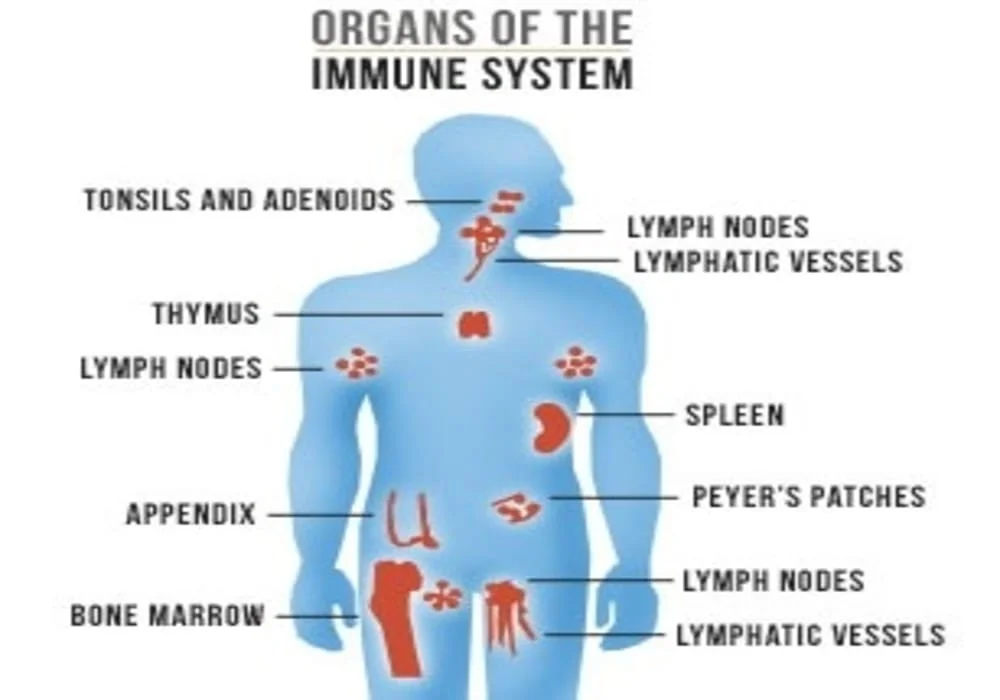Immune System
The immune system is a complex network of cells, tissues and organs that protects the body against pathogens such as bacteria, viruses, fungi and parasites, as well as tumor cells and cells infected with viruses.
Diagram:
The immune system is divided into two main parts: the innate immune system and the adaptive immune system. The innate immune system is the body’s first line of defense and includes physical barriers such as skin and mucous membranes, as well as specialized cells and molecules that identify and eliminate pathogens. The adaptive immune system is activated in response to specific infections and uses specialized cells and molecules to identify and eliminate specific pathogens.
Function:
The main function is to protect the body against infection and disease. The immune system detects and identifies pathogens that enter the body, then activates an immune response to eliminate them. The immune system is also responsible for immune memory, which allows the body to remember pathogens it has previously encountered and mount a faster and more effective response to future infections.
Diseases:
It can sometimes malfunction, which can lead to autoimmune diseases, allergies and immunodeficiencies. In autoimmune diseases, the immune system mistakenly attacks healthy body tissues, causing damage and inflammation. In allergies, the immune system overreacts to harmless substances, causing symptoms such as rashes, sneezing, and inflammation. In immunodeficiencies, the immune system is weakened or does not work properly, which makes the body more vulnerable to infection and disease. Examples of immune diseases include multiple sclerosis, lupus, rheumatoid arthritis, asthma, celiac disease, HIV/AIDS and primary immunodeficiencies.
Immune system organs and tissues
The immune system is a complex system that involves many different organs and tissues. The most important organs of the immune system are:
Bone marrow
This is the organ where white blood cells (leukocytes), including B and T lymphocytes, as well as monocytes are produced. The bone marrow is therefore essential for the production of new immune cells.
The thymus
This is a small organ located behind the sternum, which plays a key role in the maturation of T lymphocytes. The T lymphocytes produced in the bone marrow migrate to the thymus to undergo a maturation which allows them to specifically recognize the antigens and to differentiate into different T cell subtypes.
The spleen
The spleen is an organ located in the abdomen, which filters the blood and removes cells and foreign particles. It also contains B and T lymphocytes, as well as macrophages, which carry out their work of recognizing and eliminating pathogens.
Lymph Nodes
Lymph nodes are small, bean-shaped organs located throughout the body that act as filtration stations for lymphatic fluids and contain B and T lymphocytes, macrophages, and dendritic cells.
Mucosal-associated lymphoid tissues
These are tissues found in the mucous membranes of the respiratory tract, digestive tract, and reproductive tract, and contain B and T lymphocytes, macrophages, and dendritic cells. They are important for protection against infection in these vulnerable areas.
These organs and tissues interact with each other to ensure an effective and coordinated immune response against infection and disease.
Medical Genetics | The Key to Understand Chromosomes, DNA, Genes
What are their cellular components?
The immune system is made up of several types of cells that work together to protect the body against infection and disease. The main cellular components of the immune system are:
T lymphocytes
T lymphocytes are cells produced in the bone marrow and mature in the thymus. They play a key role in the adaptive immune response by identifying and eliminating virus-infected cells and cancer cells. T cells are divided into several subtypes, including T helper (Th) cells, cytotoxic T cells (Tc), and regulatory T cells (Treg).
B lymphocytes
B lymphocytes are cells produced in the bone marrow and mature in the spleen. They produce antibodies that identify and eliminate pathogens such as bacteria and viruses. B cells are activated in response to specific infections and can differentiate into plasma cells, which produce antibodies, and memory cells, which allow for a faster and more effective immune response to future infections.
Natural killer (NK) cells:
NK cells are cells of the innate immune system that identify and destroy cancer cells and cells infected with viruses. They are able to kill cells without requiring specific recognition of the antigen.
Monocytes and macrophages
Monocytes are cells produced in the bone marrow which differentiate into macrophages when they enter the tissues of the body. Macrophages play a key role in the phagocytosis of pathogens and in the presentation of antigen to T cells.
Dendritic cells
Dendritic cells are specialized cells that play a key role in the presentation of antigen to T lymphocytes. They are present in the tissues of the body and are capable of capturing pathogens and presenting them to T cells to activate the adaptive immune response.
All of these cells work together to provide an effective and coordinated immune response against infection and disease.
Information: Cleverly Smart is not a substitute for a doctor. Always consult a doctor to treat your health condition.
Sources: PinterPandai, Medical & Biological Laboratories CO. LTD, Live Science, NCBI (National Center for Biotechnology Information)
Photo credit: AIDS.gov, Public domain, via Wikimedia Commons
Hemoglobin Levels – The Vital Role of Hemoglobin in Oxygen Transport and Health



